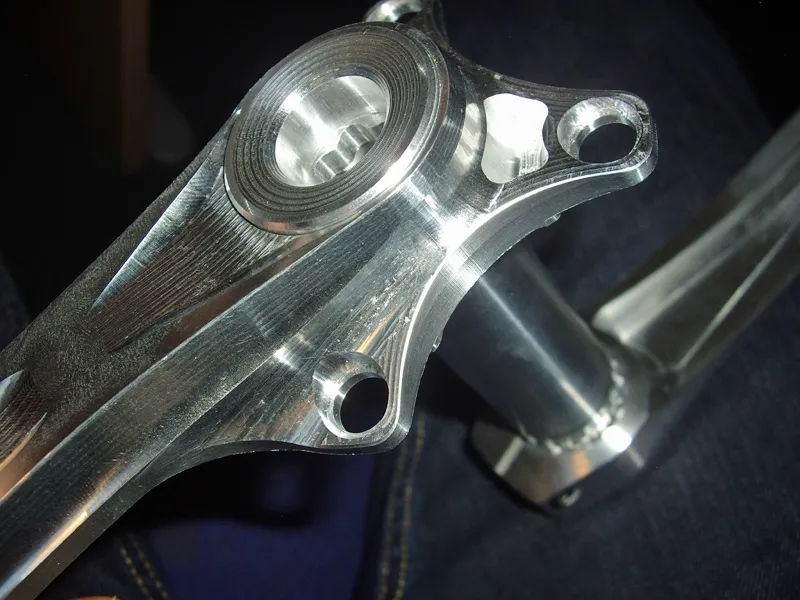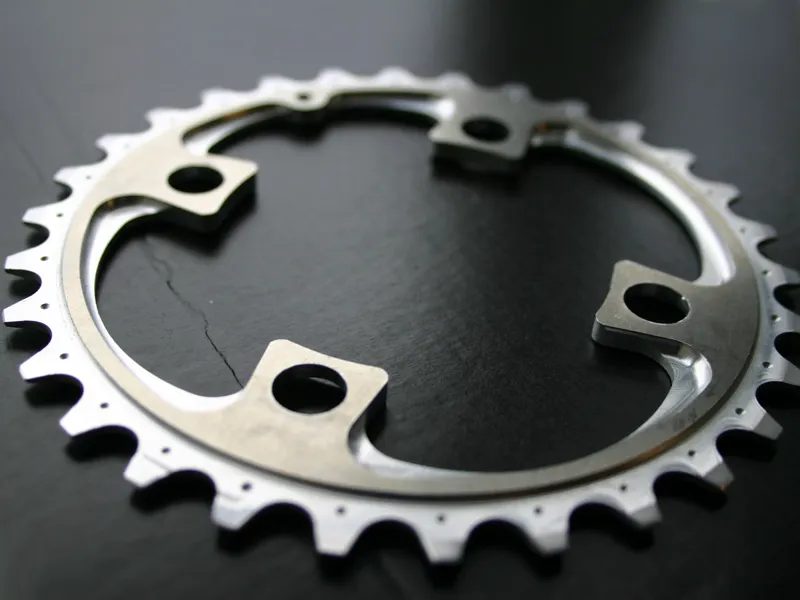When Hope Technology unveiled their integrated cassette and freehub late last year they set tongues a-wagging – ours included – about the next logical step. They already sold external bearing bottom brackets, hubs and headsets, so where else was there to go? Well, drivetrains.
Now, the British component makers have signalled that intent by showing their own concept crank. And chainrings. And a chainguide. And bashrings. Not to mention alluding to bigger things down the line.
“The crank’s a concept product that’s been on the drawing board for years and we literally made it as just that – a concept,” Hope’s Neil Arnold told us. In fact, the company are “already looking at completely overhauling it and redoing it”. The prototype seen at the UK's Core Bike show was fresh from the CNC machine shop and is a two-piece design with the splined-axle as part of the driveside crank.
The non-driveside crank slides on and is cinched up using a pinch bolt, with the bearing preloaded by using a threaded preload cap. But why show this now? “It’s part of the 1x10 or 1x9 way we’re looking at,” said Arnold. “So it’s a natural next step on from the cassette and bottom bracket – and the chain guide – and helps tie it all together.
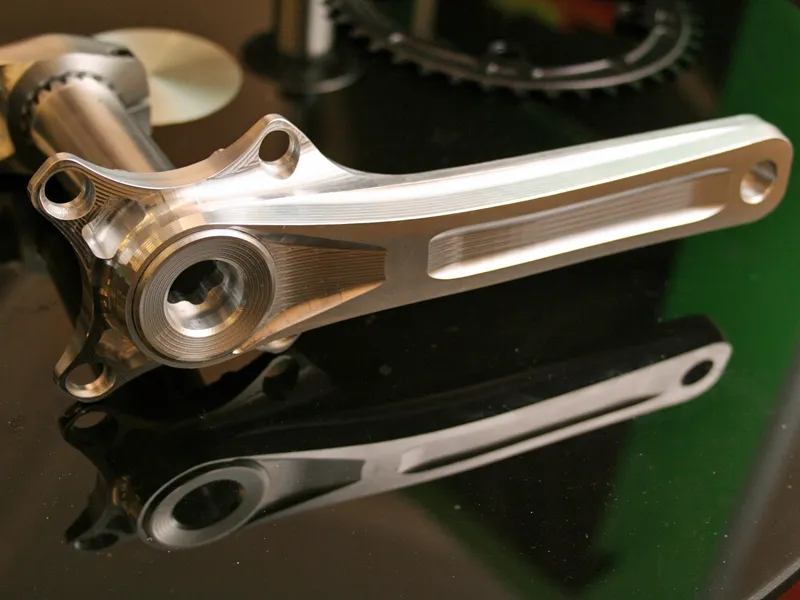
"The chain device is still a concept too but is further down the line. We’re not looking at making it a downhill device but rather it’s part of the 1x10/1x9 concept. It’ll probably be released around the time the crank is ready, although there’s no timeline yet.” As you’d expect from Hope, the chainguide is CNC-machined.
It uses an E-type bracket that mounts between the bearing cup of an external bottom bracket system, like Hope’s own, and the frame. This isn't a new idea – MRP’s 1.X popularised the concept and other brands, including the more affordable likes of Superstar Components, are out there. However, Hope’s is the only all-metal option and although it’s only a prototype it wins-out for sheer bling and beauty.
Our experience with cross-country chainguides suggests they work fine as long as you don’t back-pedal over bumpy terrain; this can sometimes make the chain derail and jam. Hope aren't discounting a lower pulley to counter this, although we wouldn’t be surprised to see both a pulley and pulley-free option.
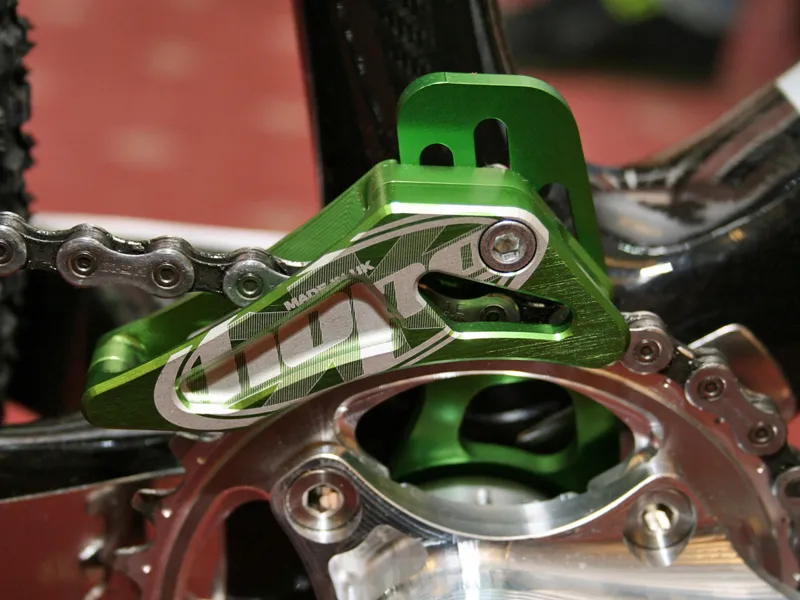
Why develop a drivetrain?
Looking back at Hope’s history it’s clear that they don’t just produce parts for the sake of it. There has to be something that they feel they can bring to the area in question in order to improve on things – whether that’s weight, practicality or simple pound-for-pound performance. So, it’s interesting that neither the crank nor the chainguide – for all its aesthetic attractions – is bringing anything new to the table, unlike the cassette.
CNC machined cranks? We’ve been there before in mountain biking's late ’80s/early ’90s heyday with the likes of Bullseye, Syncros and Cook Bros Racing (a company who've just returned to making cranks – see www.cookbros.com), among many others. So what are Hope doing? And more to the point, why? The reasoning behind the new parts stems from Hope’s interest in the 1x10 or 1x9 “way”.
Running a single chainring up front together with gears at the back requires a solution to prevent the chain derailing off the chainring – which explains the chainguide as a necessity. But the cranks? “We can make what we want as opposed to trying to improve on what’s already out there,” said Arnold.

“That’s not to say that SRAM and Shimano’s cranks aren’t good – far from it – but the cranks may not do what we want them to do so we'd have to adapt them. By making them ourselves we can have what we want from the off.” Given that Hope are going back to the drawing board on the cranks, it’s difficult not to see the chainguide becoming more integrated with the crankset and chainring. Of course, this is merely conjecture.
The rear cassette combined with an integrated freehub mechanism opened up Hope’s eyes to the wider drivetrain and, in particular, the benefits of a super-wide ratio cluster (9-36t compared to a standard 11-32t range) for 1x9/10 setups. This would give a greater range of available gears at the extremes of the cassette for climbing and descending, making the 1x10/9 transmission more usable in more situations by more riders.
“That’s ultimately where we want to get to,” said Arnold, “but mechs don’t currently exist that’ll [handle the gear range] perfectly. So, if we want to get there we’d have to look at [making our own mechs].” He was quick to add that there’s nothing intrinsically wrong with existing derailleurs – be they SRAM or Shimano – they simply don’t cater for this niche drivetrain range.
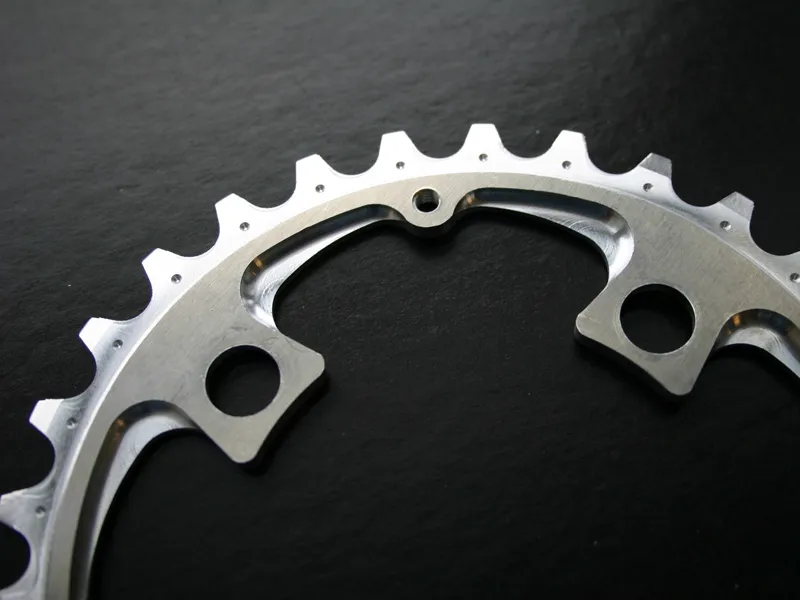
Just as the 2x10 setups now en vogue with SRAM, Shimano and FSA aren't perfect for all riders – a triple is still the better option for hilly/mountainous terrain – a 1x10/9 setup with such a wide ratio cassette won’t be for everyone. “It would be for performance-orientated riders," said Arnold. "Or for riders with a specific reason for the setup. It won’t be for riders down the woods of a weekend.”
So, will we see Hope mechs or a complete 1x10 ‘group’ any time soon? Given that it took years for Hope’s sardonically named Eternity seatpost to make production even after being unveiled to the world’s media, the smart money says don’t hold your breath. But we like the concept they're working on and, as is Hope’s way, you never know what surprises they'll spring on you in the weeks and months ahead. Hydraulic disc brakes for cyclo-cross/road bikes anyone?
The chainrings and bashrings are ready now. All are four-bolt 104BCDs (Bolt Circle Diameter); the chainrings are all hard anodised and available in 30, 32, 34, 36, 38, and 40 tooth sizes, with the bashes coming in three sizes – 32, 34-36, and 38-40t. Both chainrings and bashrings cost £35. For more information, visit www.hopetech.com.

